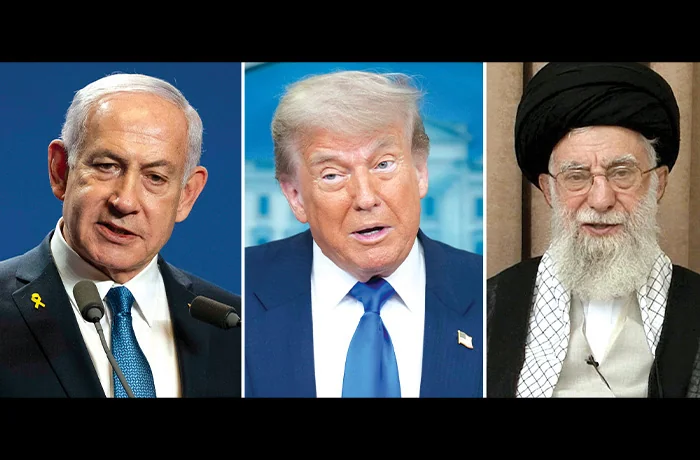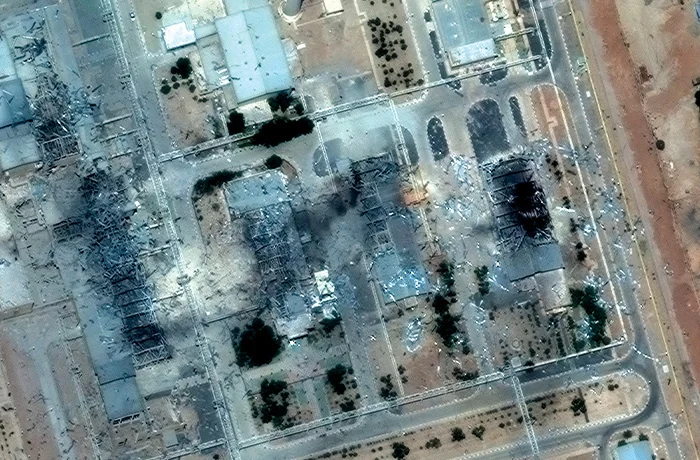The surprise attack that Israel launched against Iran in the early hours of June 13 initiated one of history’s most ingenious, complex, and successful campaigns. A tiny country, its population barely a tenth of Iran’s, projected a multidimensional preemptive strike with pinpoint accuracy over distances up to 1,200 miles without losing a single airplane or pilot. The world has not seen a similar feat of arms since 1967, when Israel, closely supported by the United States, defeated a host of Soviet-supplied Arab armies in the Six-Day War. The consequences for the Middle East, American interests, and the world will be no less significant.
Rising Lion
In the first few hours of the attacks, Israel incapacitated a regime dedicated to its destruction. The Mossad intelligence agency and commando forces, deploying on the ground and with local networks, activated a covert drone base on the outskirts of Tehran and hit Iran’s air defenses and missile launchers. Waves of jets, led by the Israeli upgrade of the Lockheed Martin F-35, bombed the Natanz Nuclear Facility. More than a dozen senior members of Iran’s military leadership were killed, many at a meeting that the Israelis had tricked them into attending. Drone strikes and car bombs assassinated the leading scientists of the Iranian nuclear program. Later that day, Israel struck the Isfahan Nuclear Technology Center, military and air bases, and the approaches to the Fordow nuclear enrichment site.
A coordinated Israeli-American disinformation plan had lulled the Iranian regime into thinking it was safe. Israeli Prime Minister Benjamin Netanyahu had let it be known that he would be taking the weekend off and flying to Athens for his son’s wedding. President Donald Trump repeated his preference for a negotiated end to the Iranian nuclear program and his hope that renewed negotiations, scheduled to take place in Qatar on June 14, would bear fruit. Operation Rising Lion, as the Israelis called it, caught the Iranian regime by surprise. For the next 10 days, the Israeli Air Force was able to operate freely over Iranian airspace and its Syrian approaches.

The Red Crescent Society reported that Israel struck in 18 of Iran’s 31 provinces in the first 24 hours. While Supreme Leader Ayatollah Ali Khamenei hid in a bunker, Israel’s precision attacks smashed Iran’s Foreign Ministry, Ministry of Defense, and the Organization of Defensive Innovation and Research, which manages Iran’s nuclear program. Missile launchers, oil fields, gasoline depots, military convoys, factories making ballistic missile parts, nuclear centrifuge production sites, the nuclear archives, and the headquarters of the Basij militia were all demolished. The Islamic Republic of Iran Broadcasting was hit during a live broadcast.
Now, as in 1967, Israel has redrawn the map of the Middle East. The Jewish state has again asserted itself as the Middle East’s preeminent military power and a linchpin of the U.S.’s global strategy. Now, as in 1967, Russia, the key supplier and diplomatic protector of a radically anti-Western alignment, has abandoned its proxies to their fate. Nor has China, Iran’s more discreet supplier of nuclear technology and the chief buyer of Iran’s illegal oil exports, stepped in. This time, however, the U.S. delivered the critical blow.
Midnight Hammer
Israel’s interdiction of Iran’s missile launchers quickly reduced Iran’s capacity to strike back. The scale and pace of Iran’s missile barrages dropped sharply after June 15. By June 18, the Israel Defense Forces estimated that Iran had launched over 400 ballistic missiles and about 1,000 drones. Fewer than 200 of the drones reached Israeli airspace. All were intercepted in the air, and none succeeded in detonating on Israeli territory. The majority of the missiles, over 60%, were also intercepted, some of them over Iraqi and Jordanian territory by the U.S. and, discreetly, Jordan and possibly Arab allies, too. Just over 20 Iranian missiles landed in urban areas.
Nor could Iran’s strikes match Israel’s for accuracy. The Iranians presumably aimed at strategic sites. They managed to start a fire in the refinery complex at Haifa Port, but otherwise, they struck civilian buildings, including the U.S. Embassy Branch Office and a school in Tel Aviv, the Soroka hospital in Beersheba, the cancer research facility at the Weizmann Institute of Science in Rehovot, a house near the home of Palestinian Authority President Mahmoud Abbas in the Arab town of al Bireh, and several apartment buildings. Advance warnings, plentiful bomb shelters, and a construction code that mandates a bomb-proof room in all recent Israeli buildings reduced the civilian toll to 29 killed and 3,238 injured. This was much lower than the IDF’s prewar predictions.

Israel had long laid plans for going it alone at Fordow, where Iran enriches its uranium to levels that exceed any possible civilian use in a fortified secret complex beneath a mountain. That would have meant extending Israel’s aerial campaign and perhaps even inserting special forces against a heavily defended site. These were not the only risks. The longer the war went on, the greater the chance of unpredictable consequences.
An Iranian attack on shipping in the Persian Gulf would cause a spike in energy prices and might drag the U.S. into direct exchanges of fire on Iran’s terms. If the war pushed the Iranian regime to sudden collapse, no one knew what might happen at the pivot of Central Asia. Avoiding foreign “forever wars” while preventing a nuclear Iran was part of Trump’s first-term record and central to his 2024 presidential pitch. The Trump administration had a clear interest in “taking the win” by forcing the war to a quick and victorious conclusion. And only the U.S. had the means to do it: the GBU-57 Massive Ordnance Penetrator “bunker-buster” bombs that could disable Fordow, and the B-2 Spirit stealth bombers that could deliver them.
On June 22, the 10th day of fighting, Trump launched Operation Midnight Hammer. In an operation of unprecedented reach, seven B-2s took off from Whiteman Air Force Base in Missouri and flew eastward for 18 hours while a second B-2 force flew westward to Guam as a diversion. A total of 125 U.S. aircraft took part in the operation, including dozens of refueling tankers and escorts that cleared the path for the strike force, guarded it in Iranian airspace, and launched diversionary attacks. A submarine launched 24 Tomahawk cruise missiles at the Isfahan nuclear site. In the first operational use of the massive “bunker busters,” the B-2s dropped 14 30,000-pound MOPs onto Fordow and Natanz. The American attack encountered no opposition, and all aircraft returned safely.
“Bullseye!!!” Trump said, striking the capitals: “Monumental Damage was done to all Nuclear sites in Iran.” Defense Secretary Pete Hegseth called the attacks an “incredible and overwhelming success.” CIA Director John Ratcliffe affirmed that “a body of credible intelligence” showed that the strikes had “severely damaged” Iran’s nuclear program and that it would take “years” to rebuild its facilities. Director of National Intelligence Tulsi Gabbard agreed that rebuilding “would likely take years” and criticized the “propaganda media” — American, that is, not Iranian — for running an “illegally leaked” early assessment from the Defense Intelligence Agency that suggested the attacks had only set back Iran by a few months, and without mentioning that this was an early, “low confidence” estimate.

Trump called it, so he got to name it. On the evening of June 23, Trump, sounding less like President Dwight Eisenhower and more like a WWE announcer, posted on social media that two 12-hour truces would go into effect from midnight that night. “On the assumption that everything works as it should, which it will, I would like to congratulate both Countries, Israel and Iran, on having the Stamina, Courage, and Intelligence to end, what should be called ‘THE 12 DAY WAR.’”
The Iranians launched a small, choreographed, and symbolic attack on Al Udeid in Qatar, the largest U.S. air base in the Middle East, and, after the ceasefire had begun, drew blood in a missile attack on Israel. When Israeli jets took to the air to retaliate, Trump told the Israelis to call off their attack and deployed Nixonian language to deliver the bluntest diplomatic statement in American history: “We basically have two countries that have been fighting so long and so hard that they don’t know what the f*** they’re doing.”
The Israeli jets turned back. The ceasefire held.
The losers’ victory
Israel has been at war for over 600 days since Oct. 7, 2023. It has smashed Iran’s “Ring of Fire” strategy of encircling the Jewish state with Islamist militias and asymmetric terrorism. Hamas is broken as a military and political force in Gaza. The Israelis assassinated Ismail Haniyeh, the leader of Hamas’s “political bureau,” in Tehran in 2024. Hezbollah’s missile arsenal, intended to devastate Israel’s cities if it tried to fight Iran, is gone, demolished by pinpoint Israeli raids in 2024, along with Hezbollah’s leader Hassan Nasrallah and the hands, eyes, and nether extremities of the Hezbollah operatives foolish enough to leave their pagers switched on. The Iranian-backed militias in Iraq stayed largely quiet during the 12-day war. The Houthis of Yemen persist in lobbing the odd missile at Israel, but Israel will clean their clock, too.
Also gone is the countdown clock in Tehran’s Palestine Square. The clock, unveiled on Quds Day in 2017, counted down the hours until 2040, when, as Khamenei prophesied, Israel would be destroyed. The supreme leader is in hiding, and Israel bombed the clock on June 23. Israel and America have also stopped the clock on Iran’s nuclear ambitions. After years of retreat and the pro-Iran tilt, America has reasserted its primacy in the Middle East. We are in a new strategic reality.
Yet again, the American media wrestled half-heartedly with the Trumpian paradox — how can an uncouth real estate tycoon and reality TV star keep getting it right and proving the experts so wrong? — and then tapped out and tried to convince themselves that the war had not ended in a resounding victory for the U.S. In this and in wishing that former Vice President Kamala Harris had won the 2024 presidential elections, the New York Times and the networks concurred with Iranian media.
Iran’s regime propagandists claimed victory, as dictatorships always do, and launched a campaign of lies and AI-enhanced fantasies. They claimed that Iran had shot down Israel’s F-35 stealth jets and captured Israeli pilots. They claimed that Iran’s rockets had leveled Israel’s cities and destroyed the Al Udeid Air Base. State broadcasters in Turkey, a NATO ally for so long that no one knows what to do about it, and Qatar, designated a major non-NATO ally by then-President Joe Biden in 2021 for services rendered during the disastrous withdrawal from Afghanistan, mourned Iran’s defeat.
Turkey’s state channel TRT Global claimed that Iran had caused “significant damage to critical infrastructure” and misrepresented an air raid alert at Ben Gurion Airport as “mass attempts to flee” at a time when, contrary to the usual population flows during wartime, Israeli airlines had launched an operation to airlift some 100,000 nationals back into the country. The Qatari-funded Islamist channel Al Jazeera, which is banned from operating in Israel because its coverage incites terrorism, claimed that Iranian strikes had caused “extensive damage.” None of this was true.
Nevertheless, America and Israel’s enemies and Iran’s useful idiots amplified Iran’s absurd spin. The BBC, another state-funded propaganda outlet in a NATO ally that cannot be trusted, claimed that the view that Iran was “close to building a nuclear weapon” was “not necessarily shared” by the International Atomic Energy Agency. That contradicted the warning in April from the IAEA’s head, Rafael Grossi, who said Iran was “not far off” from building a nuclear weapon. The BBC did not mention that Iran had accelerated its enrichment of uranium to the 60% level under the Biden administration or that in June 2024, Iran had notified the IAEA that over the next three to four weeks, it would install 1,400 advanced centrifuges at the Fordow facility. David Albright, the physicist and nuclear proliferation expert who founded the Institute for Science and International Security, assessed that this made Iran capable of enriching three bombs’ worth of 90% uranium in 10 days.
“Don’t be fooled, Israel is in worse shape than people think,” Douglas Macgregor, a retired U.S. Army colonel and active fruitcake, claimed on June 20. “About 1/3 of Tel Aviv has been damaged or destroyed. As far as their military installations are concerned, I’m told many Israeli aircraft’s [sic.] are being flown to Cyprus to avoid being struck.” Macgregor’s grip on the facts is as parlous as his grasp of grammar.
MAGA’s media isolationists were enraged. Tucker Carlson had predicted that Iran’s “fearsome arsenal of ballistic missiles” would “easily kill thousands of Americans” in the first week of fighting and claimed that Fox News host Mark Levin had an occult influence over Trump’s thinking. Carlson’s president dismissed him as “kooky” and observed that we face a choice between an Iran with nuclear weapons or an Iran without. Candace Owens, visibly disappointed by an American victory, compared Netanyahu to Adolf Hitler. Steve Bannon said Israel was “not an ally,” called Levin “Tel Aviv Levin,” and demanded “regime change” in Jerusalem.
The nation’s podcaster in chief remained silent, as if in mourning. Former President Barack Obama, the architect of the 2015 Iran deal, said nothing as Netanyahu and Trump took apart the terrorist regime that Obama had tried to make America’s partner in the Middle East. His helpers in the Democrats’ march of folly, John Kerry and Ben Rhodes, usually so loquacious, were lost for words, too. Reality will do that to an ideologue.
The 13th day
The 12-day war offers a lasting lesson in the realities of power and the dangers of delusion that should be absorbed in the capitals of the West. The domestic politics of Western democracies are consensual. They are managed by civilian experts and academic theories that do not see the use of force as legitimate. The U.S. has a handful of specialized war studies programs but more than 150 programs for peace studies. This has created foreign policies that value stability over security, confuse process with results, and mistake temporary power vacuums for the permanent hegemony of virtue.
The Democrats’ serial failures on Iran show how this mentality not only struggles to comprehend hostile motives but also weakens the U.S. before counterstrategies that operate on different assumptions and timescales. Iran’s nuclear program emerged from the heart of the mullahs’ anti-Western, antisemitic, and apocalyptic ideology and was decades in the making. Nuclear weapons would be the Islamic revolution’s sword and shield. They would erase the Jewish state from the map, subordinate the Sunni Arab monarchies, intimidate the Europeans, and ensure the Iranian regime against retaliation. They would turn a terrorist regime into a Middle Eastern empire and drive America, the “Great Satan,” out of the Middle East and Asia.
Trump has repudiated all of this vacuous proceduralism along with the shallow demagoguery of the MAGA isolationists. His Iran strikes remind us that power is not acquired by accumulating academic or moral credit. It is acquired by credible threat, proven capacity, and a willingness to take your enemy at his word. The theories of the classroom and the newsroom mean nothing if you are not serious about walking the walk.
Trump has restored American primacy in the Middle East. He has exposed Iran as a paper tiger. He has exposed the members of the Obama and Biden administrations as fools who damaged America’s political capital and strategic interests by assuming that a regime that called America the “Great Satan” could be bought off, as if the ayatollah was just another congressman. The Republican Party, dragged in Trump’s wake on foreign policy as on domestic policy, has largely dropped the delusions of Bush-era policy and accepted that military victory alone cannot create a political transformation. It can, however, open the path to it.
Those transformations may include the emergence of an Iranian regime that, like Mikhail Gorbachev when he realized that the Soviet Union was doomed, might negotiate its demise. It may lead to a popular uprising of the kind that often erupts when an unpopular regime is weakened, and even to some form of democratic or even monarchical revival. Meanwhile, it is likely to include the Iranian regime trying to rearm, maybe with Chinese, North Korean, and Pakistani help.
Iran took decades to goad Israel into its lightning war. The 13th day may also last for years. Iran is at the heart of Central Asia, and it has a long history. It is the crossroads of the energy pipelines and strategic pathways that connect Eurasia and the Middle East. While the mullahs saw Iran as the mothership of the Shiite revolution, China and Russia used it as a satellite in a greater game against America and the West. That game will continue. Iran will remain central on the map and will become increasingly central to Asia policy as China’s rivalry with America approaches its climax. The war is over for now, but peace is still far away.
Dominic Green is a Washington Examiner columnist and a fellow of the Royal Historical Society. Find him on X @drdominicgreen.























